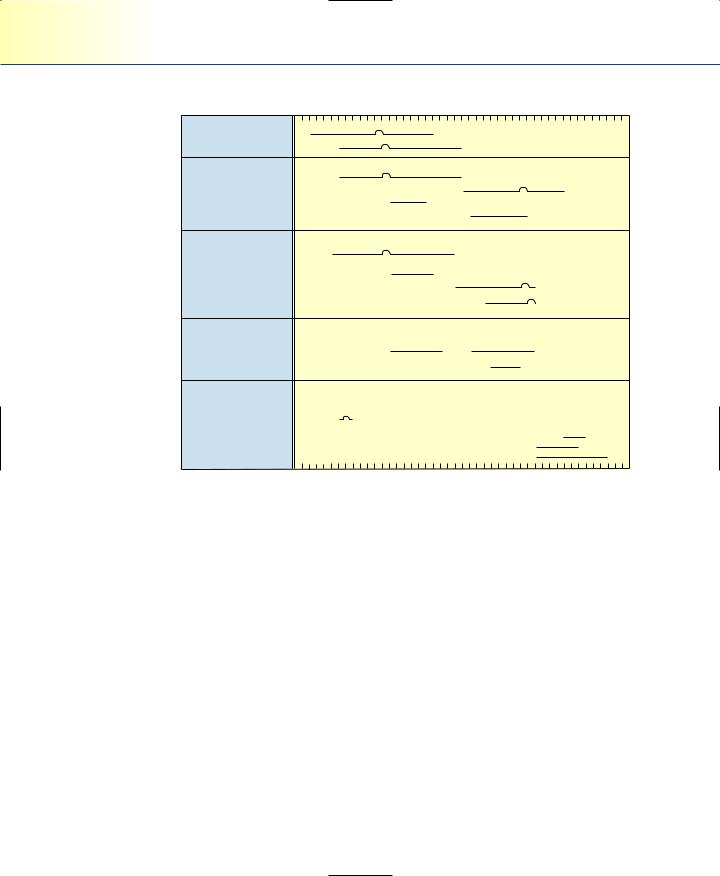
- •CONTENTS
- •PREFACE
- •Content—Benefits for Students
- •Content—Benefits for Instructors
- •Features of the Book for Students and Instructors
- •Supplementary Materials
- •Acknowledgments
- •What Is Hospitality Management?
- •The Manager’s Role in the Hospitality Industry
- •Why Study in a Hospitality Management Program?
- •Planning a Career
- •Employment as an Important Part of Your Education
- •Getting a Job
- •Employment at Graduation
- •The Outlook for Hospitality
- •Summary
- •Managing Change
- •Demand
- •Supply
- •Workforce Diversity
- •The Impact of Labor Scarcity
- •Summary
- •The Varied Field of Food Service
- •The Restaurant Business
- •The Dining Market and the Eating Market
- •Contemporary Popular-Priced Restaurants
- •Restaurants as Part of a Larger Business
- •Summary
- •Restaurant Operations
- •Making a Profit in Food Service Operations
- •Life in the Restaurant Business
- •Summary
- •Chain Restaurant Systems
- •Independent Restaurants
- •Franchised Restaurants
- •Summary
- •Competitive Conditions in Food Service
- •The Marketing Mix
- •Competition with Other Industries
- •Summary
- •Self-Operated Facilities
- •Managed-Services Companies
- •Business and Industry Food Service
- •College and University Food Service
- •Health Care Food Service
- •School and Community Food Service
- •Other Segments
- •Vending
- •Summary
- •Consumer Concerns
- •Food Service and the Environment
- •Technology
- •Summary
- •The Evolution of Lodging
- •Classifications of Hotel Properties
- •Types of Travelers
- •Anticipating Guest Needs in Providing Hospitality Service
- •Service, Service, Service
- •Summary
- •Major Functional Departments
- •The Rooms Side of the House
- •Hotel Food and Beverage Operations
- •Staff and Support Departments
- •Income and Expense Patterns and Control
- •Entry Ports and Careers
- •Summary
- •The Economics of the Hotel Business
- •Dimensions of the Hotel Investment Decision
- •Summary
- •The Conditions of Competition
- •The Marketing Mix in Lodging
- •Product in a Segmented Market
- •Price and Pricing Tactics
- •Place—and Places
- •Promotion: Marketing Communication
- •Summary
- •The Importance of Tourism
- •Travel Trends
- •The Economic Significance of Tourism
- •The United States as an International Tourist Attraction
- •Businesses Serving the Traveler
- •Noneconomic Effects of Tourism
- •Summary
- •Motives and Destinations
- •Mass-Market Tourism
- •Planned Play Environments
- •Casinos and Gaming
- •Urban Entertainment Centers
- •Temporary Attractions: Fairs and Festivals
- •Natural Environments
- •On a Lighter Note. . .
- •Summary
- •Management and Supervision
- •The Economizing Society
- •The Managerial Revolution
- •Management: A Dynamic Force in a Changing Industry
- •What Is Management?
- •Summary
- •Why Study Planning?
- •Planning in Organizations
- •Goal Setting
- •Planning in Operations
- •The Individual Worker as Planner
- •Long-Range Planning Tools
- •Summary
- •Authority: The Cement of Organizations
- •Departmentalization
- •Line and Staff
- •Issues in Organizing
- •Summary
- •Issues in Human-Resources Management
- •Fitting People to Jobs
- •Recruiting
- •Selection and Employment
- •Training
- •Retaining Employees
- •Staff Planning
- •Summary
- •The Importance of Control
- •Control and the “Cybernetic Loop”
- •Tools for Control
- •Summary
- •Leadership as Viewed by Social Scientists
- •Why People Follow
- •Leadership Theories
- •Communication
- •The Elements of Leading and Directing
- •Developing Your Own Leadership Style
- •Summary
- •A Study of Service
- •Rendering Personal Service
- •Managing the Service Transaction
- •How Companies Organize for Service
- •Summary
- •INDEX

Retaining Employees |
597 |
Each of these (and the list could be extended a great deal further) is a separate task, and for each, “one best way” will permit the greatest possible speed and the least breakage and injury. Teaching tasks separately, one at a time, may seem slow, but it is really the best way to prepare a new employee for the complete dishwasher job.
EVERYBODY GETS TRAINED
A final point is worth noting here: Training never stops. When a new employee comes to work, management can take charge of that learning process or leave it to whatever influences come along. Either way, the employee will be trained. Clearly, however, common sense sides with a planned, management-controlled training effort.
Retaining Employees
Because so much effort goes into recruiting qualified people, and so much time and trouble goes into training them, there is a clear need to hold on to good people once they come on board. We can hardly solve so complex a problem here, but
this may be a good place to review some key provisions that some companies are finding helpful. Several factors are crucial to retaining employees. As we’ve already indicated, taking the effort to get the right people is an important first step.
Second, the way people are treated makes a great difference. Praise in public for a good job, but reprimand in private when things don’t go right. Efforts to improve the two-way flow of information are important, too. In smaller units, face-to-face conversation may be enough. In larger companies, company newspapers can recognize employees’ accomplishments. At some companies, employees fill out an “employee comment slip” reporting what customers say, evaluating the food they served, and commenting on what was good or bad on their shift. Managers read these carefully. Even more companies use periodic employee surveys to assess employee morale and managers’ effectiveness in dealing with people.
Offering opportunities for advancement is important. Companies that promote from within find most of their management trainees from their own hourly ranks. They offer an opportunity for advancement that is an added inducement to performance.
Bonus and incentive programs are another method that companies use to retain employees. For example, several years ago, Buffets Inc. introduced a new incentive program designed to help them retain restaurant managers. If the unit manager signs a commitment letter and agrees to remain at his or her assigned restaurant for three years, he or she will receive a $20,000 bonus, which is in addition to the manager’s base salary and annual bonus. The unit managers then receive an additional

598Chapter 18 Staffing: Human-Resources Management in Hospitality Management
$30,000 bonus for every three-year period they remain at their assigned restaurants. Buffets, Inc. feels that the new program saves them money. The company estimates that it loses more than $20,000 in sales after a good unit manager leaves a restaurant.5
Many companies pride themselves on offering competitive pay and good benefits. A growing fringe benefit intended to reduce both turnover and absenteeism is a com- pany-sponsored day-care program. Some employers subsidize day care. A spokesman for a 300-unit Hardee’s franchisee, for instance, noted that his company did this because it employed a lot of single parents. One Burger King franchisee found that when it started to subsidize its hourly employees’ day-care costs, its turnover rate fell to one-third the industry average.
Companies are approaching their employees’ child care problems in several different ways. Some offer subsidies to the employees’ child care costs, while others provide flexible hours and make information on local day-care services available to employees. Still others make special arrangements with a national day-care provider. For instance, one company negotiated a 10 percent discount for its employees and then offered them another 10 percent subsidy. Finally, some employees pool their resources with neighboring businesses to establish a joint child care effort or establish a center themselves on site.
Staff Planning
Hospitality managers concentrate on staff planning not only because of the high proportion of income they spend on salaries and wages but also because of the great importance they attach to adequate coverage—that is, always having suffi-
cient staff in the appropriate jobs to meet the operation’s needs. Anyone who has seen a hotel coffee shop flounder when the key breakfast cook failed to show up, or a kitchen where the pot washer walked out in the middle of a meal, knows the chaos caused by the absence of just one key person. On the other hand, you may have noticed some food service operations that open at 7:00 A.M. and bring in a full dish room crew at the same time. The crew then sits around with nothing to do until the dirty dishes gradually start to collect a half hour or 45 minutes later. Proper staff planning ensures coverage, but it would avoid superfluous, wasteful coverage like this.
Because staff planning is so important, most hospitality curricula devote at least a large part of one course, and sometimes more than that, to it. In our brief discussion, we can only introduce this form of planning and some of its key tools.
JOB AND WORK NEEDS
Staff planning begins by identifying each workstation in the operation. Next, a schedule showing the number of persons needed at these stations in the course of each day,

Staffing and scheduling is as important for employees as it is for managers. (Courtesy of Sodexho.)
by time period, is prepared. This analysis usually follows the graphic pattern shown in Figure 18.6. This kind of chart shows at a glance where there is double coverage for a job and what, if any, rest periods are provided.
Because the volume of business may vary from one day to another, many operations prepare a separate schedule for each day of the week and sometimes separate sets for different seasons. Comparing actual coverage needs with staffing schedules results in constant revision of these schedules. A dollar of unneeded labor cost at one station can, at a moment’s notice, be moved to reinforce the coverage someplace else.
Once management prepares schedules of its operating needs for each day, thereby ensuring adequate coverage for each job, it can draw up a weekly schedule providing for day-off relief. The schedule for the dish, pot, and receiving crew shown in Figure 18.7 is primarily a management tool (1) to analyze seven-day schedule needs (the problem is simpler but similar in sixor five-day operations), (2) to ensure adequate coverage for each job each day, and (3) at the same time, to be sure that each employee receives the appropriate time off.
A schedule like the one shown in Figure 18.7 is also a communication tool. When posted, this schedule shows employees which person works what job for which hours each day of the week. Managers who keep their schedules in their heads and rely on simply telling people when they are to work are almost bound occasionally to have two people showing up for the same job at times and no people on other days! The result is increased cost, inadequate coverage, poor service, and low morale.
599

600 |
Chapter 18 Staffing: Human-Resources Management in Hospitality Management |
A.M. P.M.
5 |
6 |
7 |
8 |
9 |
10 11 12 1 |
2 |
3 |
4 |
5 |
6 |
7 |
8 |
9 |
10 11 12 |
1 |
2 |
3 |
4 |
Receiving
1.Rec. – John
2.Ass’t. Rec. – Pete
Pots
3.Head Pot – Al
4.P.M. Pot – Monty
2.Pete
5.Part-time Pot – Joe
Upstairs Dish Room
6.A.M. Dish – Hubert
7.Part-time Dish – Murray
8.P.M. Dish – Lou
9.P.M. Dish. #2 – Jake
Downstairs Dish Room
10.Dish. (split) – Ron
11.Part-time Dish – Art
Close and Cleanup
4. Monty
8.Lou
9.Jake
2
1
NR
5
7
11
NR
Note:
Horizontal lines indicate hours to be worked. Loops ( ) indicate rest periods. Number under loop indicates which worker covers the station during break. NR denotes No Relief.
Figure 18.6
Typical daily schedule.
PART-TIME EMPLOYEES
To complete our discussion of staff planning, we should offer a word about part-time employees. An operation often needs a position covered for only part of a shift, and it sometimes needs extra people on a job only on busy days. To hire a full-time person would obviously be an expensive solution; instead, the hospitality industry is using more part-time employees to avoid overstaffing.
Some added costs and problems result from relying on part-time people. First, an operation that uses part-time help extensively carries more people on its payroll. The same (and often a lesser) number of labor days can be worked, but more people will fill the jobs. This means more payroll records and more recruiting, interviewing, hiring, and training. Moreover, a part-time employee usually works part time because he or she has a main commitment elsewhere. (Part-timers are usually housewives, students, or “moonlighters” taking a part-time job in addition to their main employment.) Scheduling people with responsibilities outside your establishment creates special

|
M O N . |
T U E S . W E D . |
T H U R S . F R I . |
S A T . |
S U N . |
||
Receiver |
|
|
|
|
|
off |
off |
6–2:30 John |
|
|
|
|
|
N.R. |
N.R. |
Ass’t. Receiver |
|
|
|
|
|
off |
off |
8–4:30 Pete |
|
|
|
|
|
N.R. |
N.R. |
Head Pot Washer |
off |
off |
|
|
|
|
|
8–4:30 Al |
Hal |
Hal |
|
|
|
|
|
P.M. Pot Washer |
|
|
|
|
|
off |
off |
4:30–1:00 Monty |
|
|
|
|
|
N.R. |
N.R. |
Part-time Pot Washer |
|
|
|
|
off |
|
|
5–9:00 Joe |
|
|
|
|
Hal |
|
|
A.M. Dishwasher |
off |
off |
|
|
|
|
|
7:30–4:00 Hubert |
Mac |
Mac |
|
|
|
|
|
Part-time Dishwasher |
|
|
|
|
|
off |
off |
11:30–2:30 Murray |
|
|
|
|
|
N.R. |
N.R. |
P.M. Dishwasher |
|
|
off |
off |
|
|
|
4:00–12:30 Lou |
|
|
Mac |
Mac |
|
|
|
P.M. Dishwasher #2 |
|
|
|
|
off |
off |
|
5:30–2:00 Jake |
|
|
|
|
Mac |
Mac |
|
Dish (split) Ron |
|
|
off |
off |
|
|
|
11:30–3:30 |
|
|
|
|
|
|
|
& 5:30–9:30 |
|
|
Hal |
Hal |
|
|
|
Part-time Dish—P.M. |
|
|
|
|
|
off |
off |
6:30–9:00 Art |
|
|
|
|
|
N.R. |
N.R. |
Dish, Relief |
A.M. |
A.M. |
P.M. |
P.M. |
P.M. |
off |
off |
Mac |
Dish |
Dish |
Dish |
Dish |
Dish #2 |
|
|
|
8–4:30 |
8–4:30 |
4–12:30 |
4–12:30 |
5:30– |
N.R. |
N.R. |
|
|
|
|
|
2:00 |
|
|
Pot. Dish. Relief |
Head |
Head |
Dish |
Dish |
Part- |
off |
off |
Hal |
Pot |
Pot |
Split |
Split |
time |
|
|
|
8–4:30 |
8–4:30 |
11:30–3:30 |
11:30–3:30 |
Pot |
|
|
|
|
& 5:30– |
& 5:30– |
4:30– |
|
N.R. |
N.R. |
|
|
9:30 |
9:30 |
1:00 |
|
|
|
Pot. Relief/ |
|
|
|
|
|
P.M. |
P.M. |
Part-time Noah |
|
|
|
|
|
Pot |
Pot |
|
|
|
|
|
|
4:30– |
4:30– |
|
|
|
|
|
|
1:00 |
1:00 |
Dish. Relief |
|
|
|
|
P.M. |
|
|
Part-time Norm |
|
|
|
|
Dish |
|
|
|
|
|
|
|
4:00– |
|
|
|
|
|
|
|
12:30 |
|
|
Figure 18.7
Weekly posted schedule.
601

602Chapter 18 Staffing: Human-Resources Management in Hospitality Management
problems—a spouse’s vacation; exams, semester breaks, or graduation; and fatigue, to name only a few.
One significant cost advantage of part-timers is that they receive fewer fringe benefits (in many companies, virtually none). This advantage, however, is under political attack and may well disappear as future wage-and-hour legislation is enacted at the state or national level.
Although part-time employees present some problems, greater flexibility and lower payroll costs often make them economically attractive. You can expect that the work of hospitality managers in future years, as the industry’s labor shortage continues, will be even more involved with supervising and motivating part-time employees than it is today.
COMPUTERIZED SCHEDULING
Computer programs to schedule employees are increasingly common. However, people can schedule at least as well as computers can, and so scheduling programs don’t generally seem to reduce payroll hours. Rather, their great advantage is their speed. By using a computer, managers can complete their scheduling work in roughly onethird the time that doing it by hand takes. Computerized scheduling is especially helpful when there is a change in managers in a unit. Much of the experience of the manager who has been there awhile is programmed into the computer: workstations, staffing requirements, employee availability and work preferences, and peak-and-valley days and time periods. When the new manager comes in, he or she doesn’t have to learn who everyone is and what their job is. Thus, the computer offers a real convenience to managers and is a time-saver for them.
This chapter, more than the other management function chapters, has focused on the nuts and bolts of hospitality management. Staffing in the hospitality industry is obviously a nuts-and-bolts function, but one that is vital to the success of an operation.
Our approach in this chapter illustrates another fact about hospitality management: the importance of attention to detail. It is essential for management to develop sources of good employees, to look at the details found on an application, to check references carefully, to pay special attention to a new employee’s introduction to work, to base that employee’s training on individual task analysis, and to undertake painstaking staff planning. As one of the earliest hospitality educators, Bernard R. Proulx, the first head of the School of Hotel, Restaurant and Institutional Management at Michigan State University, used to tell his students, “The secret to success in the service industry is attention to detail.”
